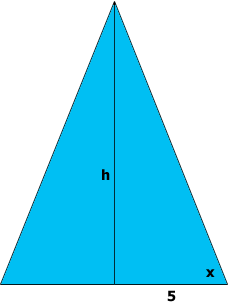| |||
| Math Central | Quandaries & Queries |
|
Question from ken: I am trying to determine the various heights of an isosceles triangle, if each has the same base dimension and varies in the degree of the base (equal) angles. What is the method to do this? |
Ken,
Wonderful question! You have made some very important observations. Your question shows impressive insight; what you have done is to discover for yourself the idea behind trigonometry. Fortunately, others have done all the hard work, so that the answer to your question comes down to using a calculator (or computer, if you prefer). The relationship you seek is called the TANGENT of the angle. It turns out to be more convenient to use HALF the base of your isosceles triangle.

Half of your isosceles triangle is a RIGHT TRIANGLE whose height h equals the height of your isosceles triangle, and whose base equals 5. The tangent of the base angle -- call it x and measure it in degrees -- is then h/5, so that
\[h = 5\times \tan x.\]
For example,
for x = 45 degrees, $h = 5 \times \tan(45) = 5 \times 1 = 5;$
for x = 75 degrees, $h = 5 \times \tan(75)$ which is approximately $5 \times 3.73 = 18.65.$
Chris
 |
||
Math Central is supported by the University of Regina and The Pacific Institute for the Mathematical Sciences.